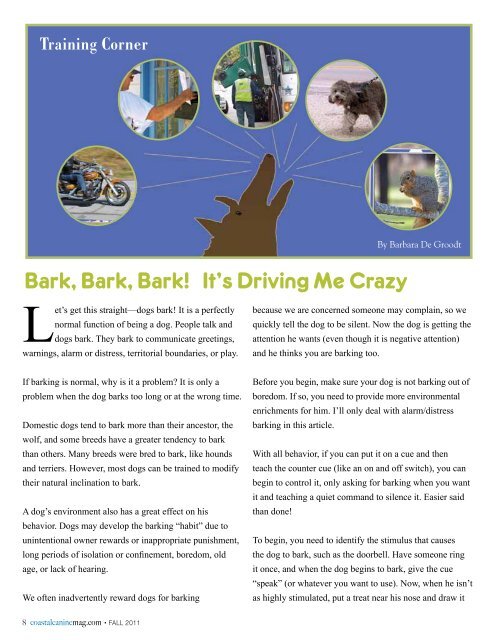For the Dogs - Coastal Canine Magazine
For the Dogs - Coastal Canine Magazine
For the Dogs - Coastal Canine Magazine
You also want an ePaper? Increase the reach of your titles
YUMPU automatically turns print PDFs into web optimized ePapers that Google loves.
Training Corner<br />
By Barbara De Groodt<br />
Bark, Bark, Bark! It’s Driving Me Crazy<br />
Let’s get this straight—dogs bark! It is a perfectly<br />
normal function of being a dog. People talk and<br />
dogs bark. They bark to communicate greetings,<br />
warnings, alarm or distress, territorial boundaries, or play.<br />
because we are concerned someone may complain, so we<br />
quickly tell <strong>the</strong> dog to be silent. Now <strong>the</strong> dog is getting <strong>the</strong><br />
attention he wants (even though it is negative attention)<br />
and he thinks you are barking too.<br />
If barking is normal, why is it a problem? It is only a<br />
problem when <strong>the</strong> dog barks too long or at <strong>the</strong> wrong time.<br />
Domestic dogs tend to bark more than <strong>the</strong>ir ancestor, <strong>the</strong><br />
wolf, and some breeds have a greater tendency to bark<br />
than o<strong>the</strong>rs. Many breeds were bred to bark, like hounds<br />
and terriers. However, most dogs can be trained to modify<br />
<strong>the</strong>ir natural inclination to bark.<br />
A dog’s environment also has a great effect on his<br />
behavior. <strong>Dogs</strong> may develop <strong>the</strong> barking “habit” due to<br />
unintentional owner rewards or inappropriate punishment,<br />
long periods of isolation or confinement, boredom, old<br />
age, or lack of hearing.<br />
We often inadvertently reward dogs for barking<br />
Before you begin, make sure your dog is not barking out of<br />
boredom. If so, you need to provide more environmental<br />
enrichments for him. I’ll only deal with alarm/distress<br />
barking in this article.<br />
<br />
With all behavior, if you can put it on a cue and <strong>the</strong>n<br />
teach <strong>the</strong> counter cue (like an on and off switch), you can<br />
begin to control it, only asking for barking when you want<br />
it and teaching a quiet command to silence it. Easier said<br />
than done!<br />
To begin, you need to identify <strong>the</strong> stimulus that causes<br />
<strong>the</strong> dog to bark, such as <strong>the</strong> doorbell. Have someone ring<br />
it once, and when <strong>the</strong> dog begins to bark, give <strong>the</strong> cue<br />
“speak” (or whatever you want to use). Now, when he isn’t<br />
as highly stimulated, put a treat near his nose and draw it<br />
8 coastalcaninemag.com • fall 2011





